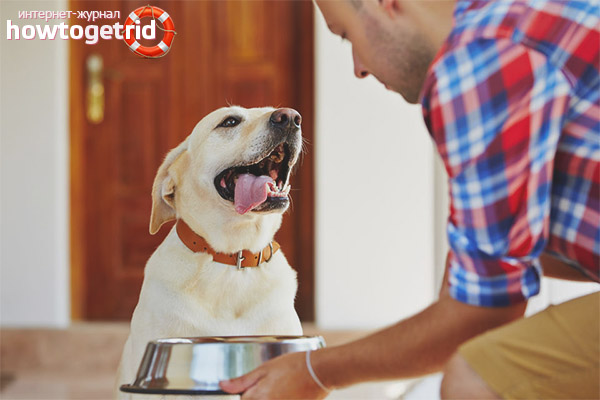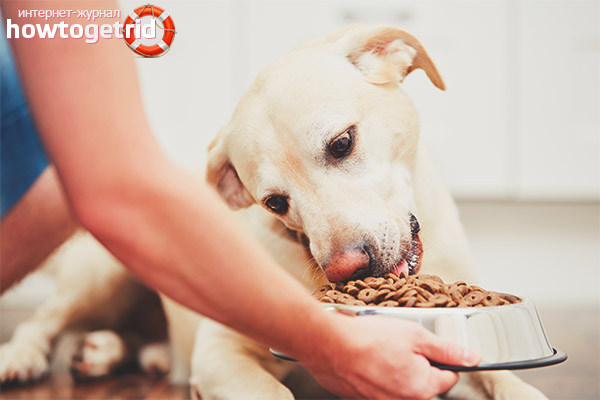The content of the article
Many dog owners, when starting an animal, do not think about the fact that they also have a well-built and balanced diet. As a rule, a dog is fed what is convenient for the owner, absolutely not taking into account the needs of the body, and also when it is convenient for a person with his schedule. However, conscious owners must understand that eating too often can lead to weight gain by the pet, and rare ones can deprive it of the necessary components and energy for natural activity.
There are a lot of breeds in the world, so how to make a diet for your animal?
Feeding rules
With the appearance of a puppy in the house, train him to the regime in the very first days. Provide comfortable conditions for eating food (a separate place, convenient bowls, temperature, lighting, privacy, etc.).
- Choose a feeding place before purchasing a puppy and do not change it without strict necessity.
- The amount of feed should be selected according to the age, activity, size of the animal, as well as the frequency of feeding. If you yourself cannot determine the optimal serving size, then contact your nutritionist or food manufacturer, but do not experiment with the dog.
- From the first days, it is advisable to draw up a feeding regimen hourly and, if possible, strictly adhere to it.
- Each feeding should contain the same amount of food, even if the dog has not eaten the previous portion. Do not leave leftovers in the plate, thereby preventing the animal from knocking down the schedule and eating “unscheduled”, shifting subsequent feeding. At the same time, observe that if the dog quickly eats the required portion of food and intensively licks the bowl, then the volume of food must be increased.
- The duration of each feeding should be up to 15 minutes. After the lapse of time, remove the bowl regardless of whether the puppy has finished eating everything.
- Do not feed the animal before a walk or an active game, as well as immediately after them. Therefore, the schedule of walks and training should also be correctly entered into the diet.
How often to feed a dog
First of all, the new owner should ask the breeder or the club representative what type of food and how often he fed the animal. It is optimal if the baby already has an established and comfortable feeding schedule for the mother after weaning from the mother’s breast. If not, you can use the following recommendations.
- At the age of up to a month, puppies use exclusively mother's milk, in which they should not be limited either quantitatively or by the duration or frequency of feeding.
- Starting from 1-2 months, solid food and water are introduced into the lure, so babies should be fed every 3-4 hours (up to 5-6 feedings per day).
- By 3 months, the number of feedings is reduced to 3-4, depending on the season, the activity of the animal and its growth.
- Up to six months, transfer the pet to 3 meals a day.
- Up to a year, it is optimal to accustom a growing dog to a 2-time feeding.
- Starting from 1 year, the animal is fed 1-2 times a day, depending on the time of the year, the intensity of walks and training, individual characteristics of the body, diet, growth and body weight. In case of feeding large dogs with natural food, portions are best divided into 2 approaches. Small and inactive pets are fed 1 time per day.
- Elderly and sick animals need to be fed 3-4 times a day, distributing, respectively, the previously set amount of food.
Separately, it is worth considering the nutrition of a pregnant and lactating female. During the gestation of the puppies, the animal can also suffer from toxicosis, which causes a refusal of food, lethargy and inactivity, which most directly affects the usual schedule of feeding the animal. In the second half of pregnancy, the dog, on the contrary, can sharply increase appetite, so the amount of food and the frequency of feeding will need to be increased according to the needs of the animal (on average 1.5 times). The doctor will help you choose the right feeding regimen after examining, weighing the animal, studying the tests.It is very important during this period to control the female’s nutrition, as the risk of obesity increases, which can cause problems during childbirth, as well as endocrine disruption.
How to estimate the frequency

When it comes to dry food, some caring manufacturers place data on the approximate volume and frequency of feeding on the product packaging, taking into account the breed, age, activity and physique of the animal. As a rule, to determine the norm according to the specified table, the owner needs to correctly weigh the animal.
In the case of natural feeding, the frequency of meals is more difficult to calculate. How to understand if the animal has enough food? First of all, this is the presence of residues in a bowl. In this case, you can either reduce the amount of servings, or increase the frequency of feeding. If the food does not remain in the bowl, but the animal has noticeably gained weight, then perhaps you need to either review the animal’s diet, or increase its activity, or reduce the frequency of feeding (all depending on the needs of the body).
It is important to understand that a feeling of fullness from food (especially when it comes to dry food) occurs after a certain time. Therefore, do not increase the frequency of feeding if it seemed to you that the animal was not full.
Objective reasons for changing diet can be:
- health status;
- decrease or increase in activity;
- change in weather conditions;
- gain or loss of body weight;
- pregnancy or estrus;
- mating period in females and males;
- compelled diet compiled by a doctor.
Determining whether a pet has obesity is not difficult. Confidently place the animal on its paws and carefully palpate the sternum and abdominal cavity: the ribs and moslaks should be palpated normally, and the muscular relief should be noticeable. Even with mild obesity, the frequency of feeding should be reduced to 1-2 times a day, increase physical activity and reduce the volume of servings. Otherwise, serious complications for the body are possible - pathologies of the cardiovascular system and musculoskeletal system, endocrine diseases.
When compiling a feeding, be guided not only by dry facts and figures, but also by the individual characteristics of your pet.
Video: how many times a day do you need to feed the dog?











Submit